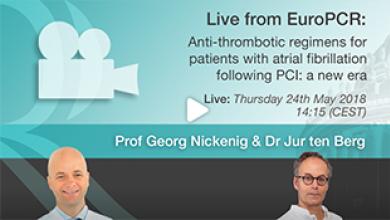Search results
Author(s):
Richard Schilling
Added:
3 years ago
Atrial fibrillation (AF) is a supraventricular arrhythmia associated with an increased risk of stroke, heart failure and all-cause mortality.1 Sinus rhythm control and heart rate control are two commonly used strategies to manage patients with AF, alongside the use of anticoagulants for prevention of stroke. Rhythm control with antiarrhythmic drugs (AADs) has similar survival benefits to rate…
View more
Author(s):
Evan Chong
,
Roberto De Ponti
Added:
3 years ago
CathRx was founded in Australia over 10 years ago with the goal of designing better medical devices. With a strong background in the pacing/defibrillator industry, its initial focus has been on electrophysiology catheters. These devices have been used for over 40 years, with little change in their fundamental design and construction. Considering the tremendous advances in understanding and…
View more
Author(s):
Maurizio Gasparini
,
Alessio Cappelleri
,
Paola Galimberti
,
et al
Added:
3 years ago
Cardiac resynchronisation therapy (CRT) is an important device-based, non-pharmacological approach that has been shown to improve the outcome in selected patients with chronic heart failure (HF). Large randomised trials have clearly demonstrated that CRT improves left ventricular (LV) function and reduces both morbidity and mortality rates.1–5 Until a few years ago, CRT was indicated in patients…
View more
Author(s):
Jason G Andrade
,
Ricky D Turgeon
,
Laurent Macle
,
et al
Added:
2 years ago
Author(s):
Frank Provenier
,
Steven Droogmans
Added:
3 years ago
Atrial fibrillation (AF) is defined as a supraventricular tachycardia with rapid uncoordinated atrial activation, beat-to-beat irregularity and frequently rapid ventricular rate.2 It is the most frequently observed sustained arrhythmia in clinical practice.3 An estimated 12 million individuals in the EU and 2.3–10 million in the US have AF, and these numbers are expected to increase as the age of…
View more
Author(s):
Neil Davidson
,
Julian Hobbs
Added:
3 years ago
The right and left atria are two complex cardiac chambers with the role of collecting venous blood from the body and the lungs, respectively, before contracting to augment the passive filling of the ventricles. This contraction is initiated and co-ordinated by the electrical conduction system of the heart. An important abnormality of heart rhythm is atrial fibrillation (AF), affecting 1–2% of the…
View more
Author(s):
A John Camm
Added:
3 years ago
Atrial fibrillation(AF), a major cause of morbidity and mortality in the Western world, is considered to be a rising epidemic.1–3 In the US alone, approximately 2.7 million people are affected by AF4 and this figure is projected to increase to an estimated 16 million by 2050.5 The rising prevalence of AF is mainly attributable to the ageing population6 and survival from other cardiovascular…
View more
Author(s):
Georg Nickenig
,
Jur ten Berg
Added:
5 years ago
Novel Approaches for AF Ablation
Author(s):
Giulio La Rosa
,
Jorge G Quintanilla
,
Ricardo Salgado
,
et al
Added:
2 years ago
Article
Author(s):
Anna E Platek
,
Anna Hrynkiewicz-Szymanska
,
Karolina Semczuk
,
et al
Added:
3 years ago
Young Investigator Award
Topic: 4. Arrhythmias
Introduction and Objectives
Guidelines of the European Society of Cardiology (ESC) from 2016 recommend pre-treatment with non- antiarrhythmic drugs (namely ACE-Is or ARBs) in patients with recurrent atrial fibrillation (AF), in whom rhythm control strategy is considered.1 This recommendation is based on possible antiarrhythmic effects of these…
View more













 « First
« First